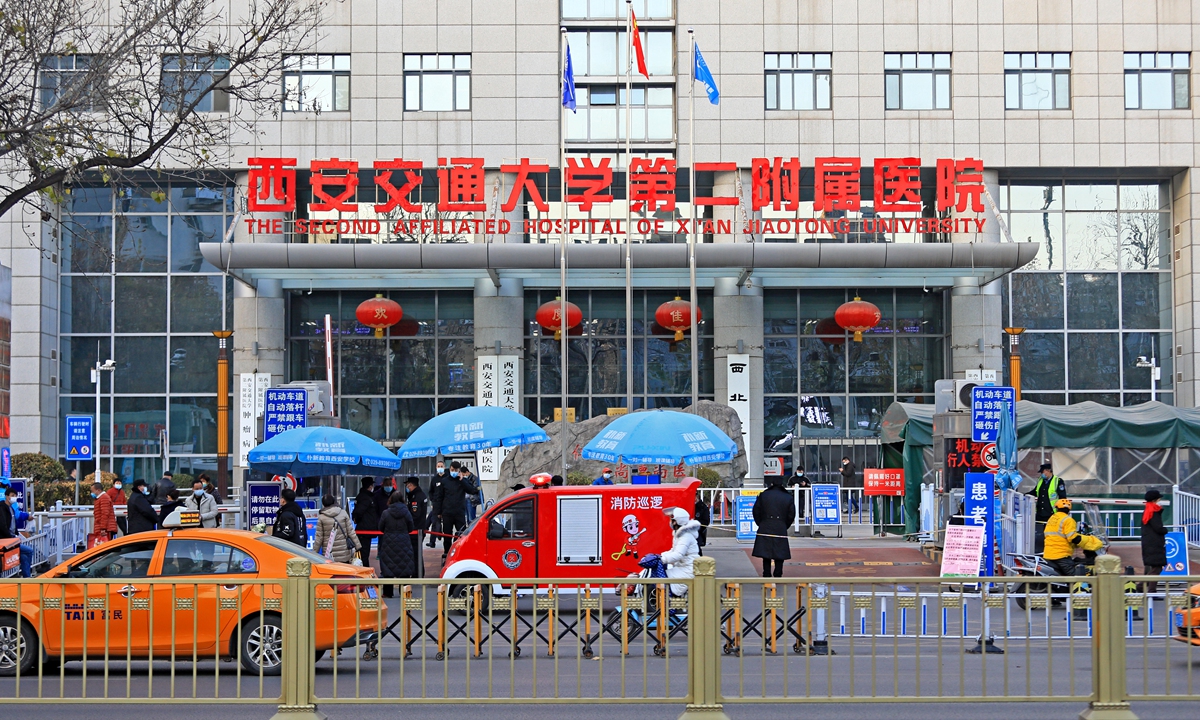Xi 'an reports hemorrhagic fever cases, but no need to panic as medical experts urge quick vaccinations

The Second Affiliated Hospital of Xi'an Jiaotong University Photo: VCG
Since the beginning of winter, Xi'an, Northwest China's Shaanxi Province has recorded a series of hemorrhagic fever cases, a natural epidemic disease with a high fatality rate. Medical experts said that rodents are the main source of infection, and called on the public not to panic as vaccinations can effectively prevent and control the disease, while human-to-human transmission is basically impossible.
The Global Times learned from a medical staff member at the infection unit of the First Affiliated Hospital of Xi'an Jiaotong University that the hospital admitted a patient with non-life-threatening hemorrhagic fever in the past few days.
Due to the recent COVID-19 outbreak in Xi'an, many hospitals with infection units have temporarily stopped receiving patients and are only attending to patients infected with COVID-19, said the staff member.
According to media reports, hemorrhagic fever is a common infectious disease in northern China. Starting from October every year, some areas of Shaanxi enter the high incidence season of hemorrhagic fever.
In recent years, the virus institute of the Shaanxi Provincial Center for Disease Control and Prevention confirmed local infections in Xi 'an by widespread field investigations and laboratory neutralization antibody detection and identification.
Experts said that hemorrhagic fever with renal syndrome, also known as epidemic hemorrhagic fever, is caused by Hantavirus, with rodents as the main source of infection.
It can be transmitted by a mouse bite, by eating food or water that a mouse has crawled over, or by contact with infected mouse blood, urine or feces.
Humans are generally susceptible to the disease, and the incidence is high among farmers who often work in the field, or workers engaged in the agricultural industry and food processing.
Hemorrhagic fever is an acute infectious disease characterized by fever, bleeding and renal damage, and it can lead to death in serious cases.
According to data released by the China CDC, the number of epidemic hemorrhagic fever cases in China from January to August in 2020 was 4,359, and the death toll was 21.
In 2019, there were 9,596 cases and 44 deaths from the disease in China, with an average mortality rate of 0.4 percent, media reports said.
Preliminary symptoms of epidemic hemorrhagic fever and common flu are similar. As a result, many patients may think it is a common cold by mistake. Medical experts in Xi'an urged patients to have treatment in a timely manner due to the onset of hemorrhagic fever and its rapid progress.
Zhou Zijun, a public health expert at Peking University, told the Global Times on Sunday there is no need to panic and it is less likely that China will have a big outbreak of the disease.
Epidemic haemorrhagic fever has at times been serious in China, so the medical response strategy has matured. Tests, targeted drugs and effective vaccines are available for the disease, medical experts said.
Also, experts noted although there are a couple of routes of transmission, the two main sources of infection are rattus norvegicus and apodemus agrarius. Neither is common in cities.
The disease has obvious regional and seasonal characteristics. People living in rural areas have more exposure to rats. People who live in urban areas are much less at risk of encountering hantavirus, have less need to panic, and have no need to kill their children's pet rats, experts said.
Two peaks come every year - the spring peak from March to May, and the winter peak from November to January.
Experts say vaccination is the most effective way for individuals to avoid the disease. People aged from 16-60 in high incidence areas, especially farmers in their 60s and students who have turned 16, should actively take the vaccine. Also, vaccination against hemorrhagic fever is recommended for those who plan to travel to endemic areas for field exploration, tourism, farming and other activities, or before long-term outdoor work assignments.
The vaccine is given in three doses, with the first two doses spaced 14 days apart and the third at least six months later. The first two shots are essential for basic immunity. If the second injection is not given on schedule, the course of this round of hemorrhagic fever immunity will be invalid, media reports said.
Another effective measure to prevent hemorrhagic fever is rodent control. Medical experts advise people to avoid activities near water, grass and other places where rats are likely to appear, and avoid contact with rats and their fecal pollutants. Rodent control and other prevention measures can be implemented in places such as villages, orchards, vegetable gardens and breeding farms.
Experts also suggested wearing long pants, long shirts and closed shoes to prevent being bitten by rats. It is recommended to wear a mask to prevent aerosol pollution in areas where weeds or straw are piled up and rat urine and dung may exist.

